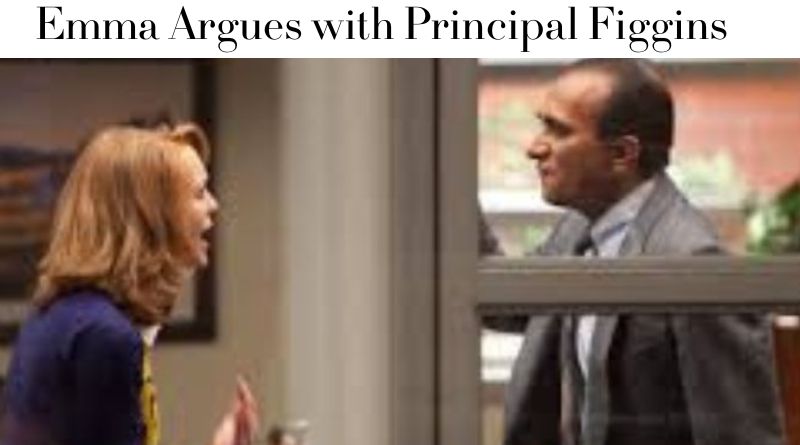The Glee TV SHOW Where EMMA Argues with Principal Figgins
Glee was a musical comedy-drama television series aired on Fox from 2009 to 2015. The show followed the glee club members at the fictional William McKinley High School in Lima, Ohio
Key details about the show
- It focused on the highs and lows of the students involved in the school’s show choir, New Directions.
- The club faced challenges like bullying from the football team and lack of funding/resources from the school.
- It addressed controversial topics like sexuality, relationships, disability, and social issues and followed the characters’ personal stories.
- Standout musical numbers were performed, covering popular hit songs from various genres.
- Over its six seasons, Glee garnered over 30 Emmy nominations and won 6 awards.
- The show emphasized acceptance, individualism, and bringing people together through music.
- It helped normalize conversations about LGBTQ+ topics and diversity in the mainstream.
- Glee stands out for realistically portraying many high school experiences and issues meaningful to younger audiences.
The Characters for this Article
Emma Pillsbury is a dedicated counselor who fiercely advocates for her students. She cared deeply about their personal growth and well-being. However, Emma also struggled with obsessive-compulsive disorder and hypochondria, which occasionally caused tension with others.
Principal Figgins had the difficult job of overseeing all operations at McKinley High. He focused on budgets, test scores, and keeping parents happy. Figgins didn’t always see eye-to-eye with Emma on more humanitarian issues that didn’t have an apparent academic impact.
Budget Battles
One of the most prevalent sources of conflict between Emma and Figgins revolved around funding for counseling services and extracurricular activities. Emma argued these programs were essential for student welfare, while Figgins faced pressure to cut costs.
During one episode, Emma stood up to Figgins after he proposed significantly reducing the counseling department’s budget. She passionately explained how supporting students’ social-emotional needs is directly tied to academic success. Though Figgins’ hands were tied financially, he eventually found compromise funding through other avenues
Emma Argues with Principal Figgins Over Discipline
She often pushed back on Figgins ‘ proposed punishments when disciplinary matters arose involving Emma’s counselee students. In one memorable scene, Emma disagreed with Figgins expelling a dyslexic student who cheated on a test due to feeling overwhelmed. She persuaded Figgins to offer tutoring instead.
Their diverging perspectives highlighted potential tensions between compassion-focused counseling and zero-tolerance administrative policies. Through discussion, they generally found balanced solutions factoring in each student’s full circumstances and needs.
Impact and Discussion
Glee spotlighted issues still relevant in schools today regarding funding priorities, discipline approaches, and advocating for marginalized groups. The show informed meaningful conversations about educational policy and practice by humanizing these discussions through Emma and Figgins’ relationship
While disagreements were familiar, their character partnership showed administrators and counselors could work through differences constructively with open communication and mutual understanding of respective pressures. Overall, Emma and Figgins demonstrated how effectively addressing student issues requires considering multiple viewpoints.
Advocating for Clubs and Programs
Emma was often the driving force behind new clubs and initiatives that supported students. She recognized how these extracurricular activities could boost engagement and well-being. Figgins was skeptical of costs until Emma convinced him of the long-term benefits
One example could be Emma founding the school’s GSA club to make LGBTQ+ students feel included. Figgins resisted at first but came to understand its importance
Emma Argues with Principal Figgins over Sensitive Student Issues
When sensitive personal issues arose for students, like unplanned pregnancies, Emma prioritized counseling while Figgins worried about optics. Through respectful discussion, they found balanced solutions that maintained student privacy but addressed parent/community concerns.
Emma helped Figgins see situations through a humanitarian lens rather than just policies, showing how counselors can educate administrators
Lasting Impact on Education Policy
Topics Glee tackled through Emma and Figgins’ evolving partnership have sparked honest discussions among counselors and administrators. Advocacy training now emphasizes understanding multiple viewpoints. Funding considers social-emotional needs, not just testing. Overall, student well-being and collaborative approaches to sensitive issues have value alongside academic achievement. Their relationship paved the way for healthier, more nuanced education systems
Navigating Student Mental Health Issues
Emma helped Figgins recognize how undiagnosed conditions like depression or anxiety can severely affect learning. Through education on available services, they worked to support struggling students rather than exclusively disciplining behavioral issues
Inclusivity and Avoiding Discrimination
When the school faced discrimination lawsuits regarding LGBTQ+ policies, Emma advised Figgins on inclusive guidelines grounded in empathy, not legality alone. He learned discrimination has long-term ramifications beyond immediate complaints
Bridging Achievement Gaps
Emma brought awareness to Figgins about how often socioeconomic factors or bias influence standardized scores disproportionately. They implemented outreach programs helping underserved student populations achieve their full potential.
Addressing Student Trauma
High-profile events like school shootings prompted serious discussions between Emma and Figgins on comprehensive safety plans balancing physical security and mental health support
Inspiring Future Education Leaders
The collaborative problem-solving modeled by these characters has influenced many current administrators and counselors. Universities now emphasize the importance of understanding multiple stakeholder perspectives to enact more equitable, compassionate policies
Balancing Academics and Wellness
Emma worked with Figgins to implement wellness programs like yoga classes, therapy dogs, and mindfulness sessions that addressed high-stress levels without distracting academics. Data showed these initiatives boosted grades by promoting mental health
Overcoming Systemic Barriers
Figgins learned from Emma about systemic obstacles like underfunding Title 1 schools that perpetuated the achievement gap. They advocated at board meetings for restructuring budgets to support disadvantaged communities and determine student potential beyond test scores.
Responding to cultural shifts
Students considered Emma an ally for burgeoning social movements like Black Lives Matter. She educated Figgins on intersectionality and supporting marginalized voices, influencing McKinley to review the curriculum and launch inclusion committees.
Emma Argues with Principal Figgins on Addressing educator biases
When teachers exhibited microaggressions, Emma counseled Figgins on implicit bias training to foster an equitable and psychologically safe learning environment. Data-driven solutions evaluated progress in curriculum and discipline practices over time.
Impacts of social media
Rising mental health issues related to things like cyberbullying led Emma and Figgins to implement online safety assemblies, anonymous reporting tools, and a digital citizenship curriculum to help students navigate modern challenges
Fostering hope amid hardships
Through compassionate outreach, Emma motivated struggling students to persevere despite obstacles like poverty or toxic home environments. Figgins saw her empower marginalized groups, influencing him to broaden his vision and support college aspirations for all.
Critical Features Of this show
- Partnering with parents: Emma worked with Figgins to establish parent support groups and conduct home visits for at-risk families, which helped address issues like truancy from a holistic perspective.
- Preventing school violence: In the wake of mass shootings, Emma led trauma-informed training while Figgins upgraded security. Balancing deterrence with emotional support minimized fears while catching troubled youth before issues escalated.
- Supporting LGBTQ+ students: Emma advised Figgins on establishing gender-neutral facilities and anti-bullying protocols. It created an affirming environment where all students felt safe learning and growing into their identities.
- Closing the special needs gap: Emma partnered with special ed teachers to update IEPs based on student strengths instead of weaknesses. Figgins backed inclusive classrooms where extra support led to higher aspiration and achievement over time.
- Promoting health and safety: Emma worked with Figgins to reshuffle PE classes, update nutrition standards, and install health facilities like a clinic or outdoor classroom that mitigated illness-related absences.
- Advocating for educators: Emma helped Figgins establish wellness days and mental health stipends to prevent teacher burnout, leading to lower turnover and more cohesive learning communities with invested staff.
Wrapping up the impact of Emma and Figgins’ relationship on Glee:
Emma Pillsbury and Principal Figgins brought important educational issues to light engagingly through their respectful yet spirited debates over six seasons. Whether disagreeing on budgets, discipline policies, or new initiatives, their discussions highlighted real challenges schools face.
More than that, the characters demonstrated that student advocates and administrators can find solutions when both parties listen openly. By humanizing pressures on counselors and leaders, Glee showed these roles frequently want the same outcome – student success and well-being.
Most importantly, Emma and Figgins addressed the whole child, not just tests, and created a system supporting all. Their dynamic laid the groundwork for how diversity improves policy talks. Today, their influence is increasing holistic approaches across education.
In the end, the entertainment power of Glee transformed dry debates into unifying conversations. By bringing people together through music on screen, Emma and Figgins did the same thing off-screen – starting a dialogue that still rings true for youth. Their relationship was a reminder collaboration, not conflict, progresses communities

